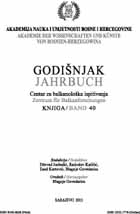Izvještaj o arheološkim, geofizičkim i palinološkim prospekcijama na Kupreškom polju/Bosna i Hercegovina 2009–2011. godine
Report on archaeological, geophysical and palynological prospections in the Kupres polje/Bosnia and Herzegowina, 2009–2011
Author(s): Frank Schlütz, Nils Müller-Scheessel, Felix Bittmann, Roland GaußSubject(s): Archaeology
Published by: Akademija Nauka i Umjetnosti Bosne i Hercegovine
Summary/Abstract: During the campaigns in 2009 to 2011 now five grave mounds and parts of their wider surroundings have been prospected geomagnetically. The results obtained are mixed: While in the mound “Strljanica” only late medieval tombs were observable, in the geomagnetic picture of the mound “Uzur glavica” a massive stone packing seems to be visible, which has possibly surrounded a grave chamber. On the other hand, the prospection of the smaller grave mounds yielded no useful outcome. Interesting results were observed in the GPS based topographic recordings: With them it could be demonstrated that the mounds had been built on small natural elevation, so that the mounds appear more imposing. In the same direction pointthe locations of the mounds, which could be determined by GPS surveys. According to these findings, it can be assumed that the mounds had been built with far-reaching visibility in mind, which implies in turn that this visibility was not hindered by the larger stretches forests. In this context, the analysis of the view shed of the “Velika gradina” is interesting, as it seems to suggest that care was taken that they were not mutually visible. Finally, the discovery of numerous small grave mounds on the eastern slopes of the Kupreško polje has to be regarded as another important result. Further research into the grave mounds of the polje Kupreško is planned: It would be desirable if detailled topographic recordings existed of all of the grave mounds and groups of grave mounds. On present knowledge, this could be accomplished best by 3D laser scanning or by series of aerial photographs. Aerial photographies from TARA (The Aerial Reconnaissance Archive), dating to the 1940s, can yield additional information about the grave mounds, e. g. by identifying the position of mounds now destroyed, by helping to differentiate between actual mounds and heaps of field stones and by recognising unknown mounds. Furthermore, palynological studies studies should be initiated, which are likely to be extremely promising, given the nature of the karst landscape and numerous lakes without outflow. They could clarify whether the Kupreško polje at the time of the construction of the grave mounds was actually lacking forrest as much as previously postulated. As the test drillings have shown, the conditions for the preservation of organic matter are excellent. In terms of the grave mounds further non-destructive screening would be desirable. Since the possibilities of geomagnetic investigations seems largely exhausted – because of the “noisy” underground more informative results are hardly to be expected – alternative methods such as GPR and geoelectrical prospection should be used. Many of the above mentioned issues such as the dating problem, however, can only be answered by systematic excavations.
Journal: Godišnjak Centra za balkanološka ispitivanja
- Issue Year: 2011
- Issue No: 40
- Page Range: 63-89
- Page Count: 27
- Language: Bosnian

